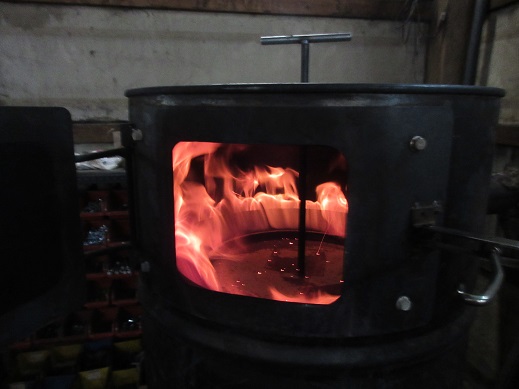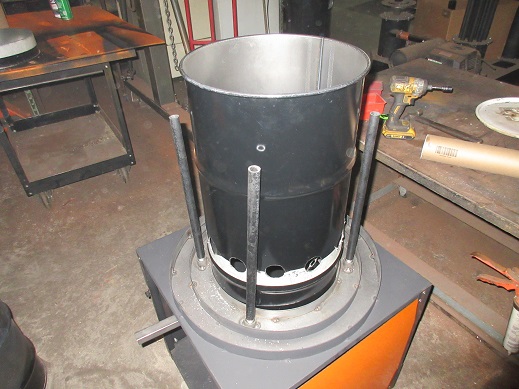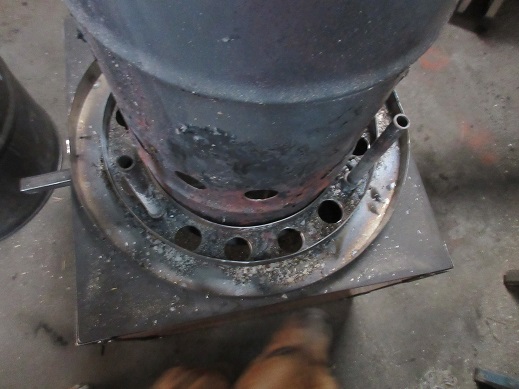Outstanding! Thanks, Til!  Watching all 11 (short) clips. Cool!
Watching all 11 (short) clips. Cool!
I once again have system to be able to view videos at presented speed.
No loss for too much being put up out there.
Has been a huge loss for the really good works done by some such as this UK farm fellow.
His evolved system is supremely DOer Practical.
Thanks much for putting this up Til.
S.U.
Thank you for the video.
Begging your pardon, I have a few questions.
1.) I appears that your using the waste heat to dry the next batch of charcoal material in the upper barrel. Is that correct?
2.) Does the upper barrel get hot enough make charcoal on it’s own. Meaning that wood gas instead of steam comes out of the upper barrel axle?
3.) How many batches of charcoal do you get on the bottom barrel before you have to replace the barrel?
Thank you very much.
Hi Mark,
The barrel at the top gets preheated with the waste heat from the bottom barrel cooking.
If the bottom one is “done” the its been taken out, replaced with the top one.
Then the top one gets replaced with a fresh one… The cycle continues as long as you wish / do it
Some way to make charcoal, then use it in a gasifier…
This is the military department for teaching rural farmers
Hey Koen; That was an exalant video. Even though it wasn’t in English, they made the pertanent points very clear; especially the point you have to wait and wait and wait.TomC
Happy belated birthday. For some reason I couldn’t post on FB!!!
Thank you very much. That was a good video.
On your two tier retort, How many batches of charcoal can you make with the lower drum before it has to be replaced?
What with the covid, steel drums, are getting hard to find in my bario.
So I dug the fire pit out and built a pit for the retort Im experimenting with. .This has a loose grate between two barrel drums. Bottom is a catch that can be sealed off and the top is the hopper. Automation will certainly make charcoal production much faster and efficient.
For now we make charcoal while we have a campfire 




since I found this… and didn’t see this style posted… it has a warmer tube up the middle, then another small tube to take gases from the top of the inside down to the bottom out a hole in the bottom of the barrel. IThey said it took like 2 hours to get it up to temp to where the the wood gas would catch fire. The ones with the shroud and are heated on the outside have to be faster because of surface area. That shroud thing is an oil drip burner. I personally think the designs that heat from the outside are probably a lot faster because of surface area.
Hi Sean , they are basically " Hookway " design retorts shown on YouTube and the ones in the video are the exact same as the one i have been using for a few years now apart from sitting the barrel on top of bricks i dug a pit and sat drum on top to burn the old crappy wood to get it going , then roll it on side and block off the 6 inch stove pipe till cool off and shovel out charcoal into sealed drum takes me about 2 hours to make a drum full of charcoal from bone dry wood .
Dave
PS you get great quality charcoal from the indirect method ,but the drums must be insulated for fully cooked
I thought hookway had something else going on. I didn’t realize it shoved gas back down towards the bottom with another pipe.
Do you think it would would well if you moved the gas exit pipe to one side, then just heated the outside of the barrel? The middle pipe limits the size of the wood you can put in, but you could make that optional by giving it a spot to screw in at the bottom, like one plate has the tube hole, and another is solid, and you would also have to switch the lids, but that might be ‘not worth it’ since a different barrel would work as well.
Sean the Hookway has a pipe that allows condensation and gas to flare off on top first and then when shut off it sends the gas down into the J tube part of his set up . moving the pipe from the middle would not work as designed allowing the heat from the center tube to radiate out all around , also with out insulation on the outside the cooking is very hit and miss allowing cooler area’s not fully cooking the wood .
If you want to remove the center pipe and throw the barrel onto a burning fire i guess that would work , but you would need to cover the part of the drum that is not in the flames as they will not get cooked unless you can roll the barrel around in the fire
My design is a lot simpler and is continuous fed.
Turn your volume up, what you are hearing the release of pyrolysis gas expanding and leaving the lower jets mixing with primary combustion. The fuel supplies its own fuel for combustion. You just keep feeding it and it keeps spitting out charcoal.
Put the bell on and then the gases leaving out the top become down draft and reheat the fuel making it much hotter. Its just a giant TLUD with a bell on top of it.

I really like the way you are changing ways of making and running charcoal machines Matt , i can imagine the regular guys wanting to buy the whole set up as a plug and play system , great work on your part .
I will have to go back and look how this works as it looks to me as the top of the barrel has a plunger that’s pushing the wood down and forcing the gasses and flames downwards before coming back up the sides on top , there is a grate between the 2 barrels that hold back the wood until charred i seem to remember , so simple and idea seems to work very well .
Dave
Since you mentioned “the size of wood,” remember that moisture and volatiles leave the end grain 8-10 times faster than than through the side of split wood. Short pieces are going to pyrolyze/carbonize better than long pieces. There is a trade-off between cutting and splitting.
No its just a lid held down by gravity. When you load you remove it and fuel up and then replace it. If you note in the pictures with the bell on top, there is a T handle attached to it. That is so I can pull up the lid to load fuel in it. You want the pyrolysis gases to expand downward and mix with the combustion gases so they fully burn off. Then as this full combustion gas is leaving the jets its indirectly heating the the fire tube that the fuel is held in.
This is is what it looks with out the lid.
The fire you see is not originating there at the top. It is originating down at the bottom, there is not any oxidation of the fuel 2/3 from the top down to where the exhaust jets are. It works just like a TLUD stove, just way bigger
See these big holes? That is where the fire you see is originating from. From these holes down the grate is the only place any fuel can oxidize. Anything above these holes is simply baking in there. If you throttle it down after a while you will hear a big crash!! It almost sounds like a broken glass. That is the fuel just breaking apart and crashing into the catch barrel. I will have this at Argos this year if I can make it.
Theoretically when the fuel really begins gasifying there is only so much volume that can exit those holes. So as the pyrolysis gas expands and takes off, this displaces the air that can enter the oxidation chamber so very little fuel is actually being oxidized once the gasificion process takes off.

These holes in the bottom plate are the second stage air feed. This is what gives it that rumble. The video does not do this justice it sounds like a jet engine.

Thanks Matt , much better seeing it and reading your description of it , and it sure looks a great way if you have the time to be around feeding it as i do from time to time i might give this idea a trial out the back here once the burn ban is lifted in month or so .
Cheers Dave
yeap. I have been watching.  It is definitely an interesting design.
It is definitely an interesting design.
Very smart efficient idea…



